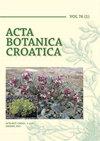土耳其极度濒危物种Achillea sivasicaÇelik et Akpulat(菊科)的解剖学研究
IF 0.7
4区 生物学
Q3 PLANT SCIENCES
引用次数: 6
摘要
本研究首次对土耳其濒危特有植物水蛭(Achillea sivasica)的根、茎、叶中脉、叶面解剖及瘦果显微形态进行了研究。在本研究中,在初生期晚期和次生生长期早期发现了根。它在周下有一个由12-16行细胞组成的大皮层。根部有5-12个分泌细胞包埋于皮层,位于维管束附近形成的分泌管,处于次生发育的早期。茎在横截面上呈圆形-五边形。五角形角表皮下有层片状厚壁组织,角间有皮层薄壁组织。分泌导管位于韧皮部附近,在束间区皮层和内皮层之间。内胚层明显,其细胞与相邻的内胚层细胞有凹痕和突起,加强了它们之间的联系。此外,许多内胚层细胞中有明显的casparian条带。叶中脉区呈三角形横截面。木质部厚壁纤维两侧有分泌管,由4-5个分泌细胞组成。叶片为两形气孔,气孔类型为无形细胞。叶肉层等面。分泌管较大,直径大于最近的主层维管束。水杨树瘦果形状为披针形-长圆形,表面有棱纹,无毛。本文章由计算机程序翻译,如有差异,请以英文原文为准。
Anatomical investigations of the Turkish critically endangered species: Achillea sivasica Çelik et Akpulat (Asteraceae)
In this study, the root, stem, leaf midrib and leaf lamina anatomy and achene micromorphology of the Turkish critically endangered endemic Achillea sivasica were investigated for the first time. In this study, the root was found in late primary growth and in early secondary growth stage. It has a large cortex layer consisting of 12-16 cell rows beneath
the periderm. Secretory ducts formed by 5-12 secretory cells embedded in the cortex and located near the vascular bundle were found at the root, which was in the early stage of secondary development. The stem was circular-pentagonal in cross-section. There was lamellar collenchyma
beneath epidermis of pentagon corners, and cortex parenchyma between corners. Secretory ducts located near the phloem, between the cortex and
endodermis on the interfascicular region, were also observed. An endodermis layer was evident and its cells have indentations and protrusions where they touch adjacent endodermis cells, which strengthens the connection between them. In addition, casparian strips were conspicuous in many endodermis cells. The leaf midrib area had a triangular cross section. There were secretory ducts, consisting of 4-5 secretory cells observed on both sides of the sclerenchymatous fibers that accompany the xylem. The leaf lamina was amphistomatic and stomata type was anomocytic. Mesophyll layer was equifacial. There was a large secretory duct and its diameter is bigger than the nearest main lamina vascular bundle. Achene shape of A. sivasica was lanceolate-oblong and its surface was ribbed and glabrous.
求助全文
通过发布文献求助,成功后即可免费获取论文全文。
去求助
来源期刊

Acta Botanica Croatica
PLANT SCIENCES-
CiteScore
2.50
自引率
0.00%
发文量
34
审稿时长
>12 weeks
期刊介绍:
The interest of the journal is field (terrestrial and aquatic) and experimental botany (including microorganisms, plant viruses, bacteria, unicellular algae), from subcellular level to ecosystems. The attention of the Journal is aimed to the research of karstic areas of the southern Europe, karstic waters and the Adriatic Sea (Mediterranean).
 求助内容:
求助内容: 应助结果提醒方式:
应助结果提醒方式:


